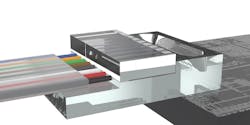Optoscribe introduces glass component for high-volume fiber-to-silicon-photonics coupling
Optoscribe (Livingston, UK), which makes 3D glass-based integrated optical components, has launched a monolithic glass chip for low-loss coupling of light into silicon photonics grating couplers, which it calls OptoCplrLT. Silicon photonic (SiPh) circuits, which are manufactured lithographically and as a result are 2D structures, often contain gratings to couple light into and out of the circuit's 2D plane; the trick is then to design simple and efficient 3D bulk optics to couple light from optical fibers down to the gratings in the circuits. This is what Optoscribe says it has done with its OptoCplrLT couplers.
Optoscribe states that OptoCplrLT is designed to overcome fiber-to-SiPh photonic integrated circuit (PIC) coupling challenges to enable high volume automated assembly and help drive down costs. Created using Optoscribe’s proprietary high-speed laser writing technique, OptoCplrLT has low-loss light-turning curved mirrors formed in the glass to direct the light to or from SiPh grating couplers. This setup eliminates the need for bend-tolerant fiber configurations, which are often expensive and challenging and have significant limitations in size and profile.
To help address footprint challenges, OptoCplrLT has a low-profile interface of less than 1.5 mm in height, allowing compact interface layouts that alleviate packaging constraints. It is also compatible with industry-standard materials and processes; for example, the glass chip has a coefficient of thermal expansion matched to the silicon chip, minimizing thermally induced stresses.
Russell Childs, CEO of Optoscribe, notes that OptoCplrLT will help meet market demands relating to performance, cost, and volume, as well as help to overcome existing hurdles that include SiPh transceiver packaging and integration.
Optoscribe's experience in glass components is extensive, as the company already designs and manufactures 3D glass-based optical components for the telecommunications and data communications markets. Using its laser direct-write technology, Optoscribe fabricates precision fiber alignment arrays, fiber-to-fiber interconnects, multicore fiber fanouts, photonic lanterns, transceiver photonic integration platforms, SiPh coupling solutions, and optical subassemblies.
For more information, visit: www.optoscribe.com
Got optics- and photonics-related news to share with us? Contact John Wallace, Senior Editor, Laser Focus World
Get more like this delivered right to your inbox

John Wallace | Senior Technical Editor (1998-2022)
John Wallace was with Laser Focus World for nearly 25 years, retiring in late June 2022. He obtained a bachelor's degree in mechanical engineering and physics at Rutgers University and a master's in optical engineering at the University of Rochester. Before becoming an editor, John worked as an engineer at RCA, Exxon, Eastman Kodak, and GCA Corporation.
